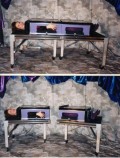Thin Model Sawing (a lady in half)
Designer: Zati Sungar
In the Thin Model Sawing, an assistant reclines in a box that barely covers her. Her head is visible on one end and her feet on the other. The magician then saws through the slot in the box using a large handsaw, cutting through thin wooden strips placed in the sides of the box to prove that the saw is real and capable of cutting. As the assistant’s head and feet are both visible to the audience, this makes it clear to them that, in addition to sawing through the box, the magician is also sawing through the body of the assistant within. Having sawed through the box, the magician then removes the saw and inserts two metal divider blades into the slot in the center of the box, dividing it into two separate halves. The two table halves are pushed apart allowing the magician to walk between them. The narrow side doors are then opened allowing the assistant’s legs to be seen inside the lower section and also allowing her to extend her arm out of the door in the upper section. With many assistants, this then allows them to wrap their fingers around the end of the box and feel the outer surface of the blade there. Having demonstrated that the assistant has indeed been cut in half, the table halves are then pushed back together and secured by the latches and the side doors closed. The blades are then removed, followed by the neck and ankle stocks. Finally, the box lids are unlatched and opened, allowing the assistant to stand up within the box and show that they are safely back in one piece. The magician then helps the assistant down from the table, and they take their bow.
One of the most common variations is the omission of the wooden strips from the side. This means that, as the magician saws through the box, there is no sound of him also sawing through wood.
Milbourne Christopher in his Illustrated History of Magic credits a Turkish magician, Zati Sungar with shrinking down the size of the typical “Sawing in Half” box and thus creating what we call today the “thin model” sawing. Sungar developed this illusion around the 1936 according to Steinmeyer’s The Complete Jarrett. Some credit Guy Jarrett with this illusion (Jarrett having developed a similar illusion some ten years prior), but it lacked the “completeness” that the Sungar illusion possessed. Numerous variations have been developed since that time. Robert Harbin’s contributions were probably the most unique. He created a portable Bow Saw version and then elaborated greatly on the theme and created the famous Zig Zag Lady!
Around 1945, Sungar traded his secret to Tihany. Bob Towner witnessed Tihany’s secret and brought it to John Daniel of Owen Magic in California. John Daniel and Carl Owen then created the prop that has been used since the late 1950s.
Guy Jarrett’s Thin Model Sawing was not nearly as wide as the modern versions, Jarrett’s model being about 16 inches wide. Though Jarrett didn’t reveal his secret in his 1936 book, he did tell about the secret in later years. Steinmeyer mentions in The Complete Jarrett that John Daniel met Jarrett at Joe Berg’s magic shop in Hollywood in the early 1960s. Daniel showed Jarrett the Owen thin model sawing photo and Jarrett explained that he had a similar sawing but that a panel in one of the boxes allowed the boxes to be thinner. Further details will not be revealed here but can be found in The Complete Jarrett.
Photo Credit: Magic Makers Inc. (Canada) (purple box)



